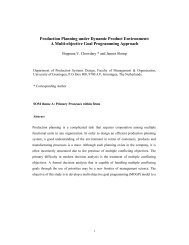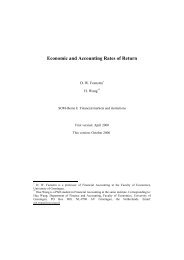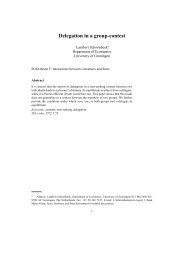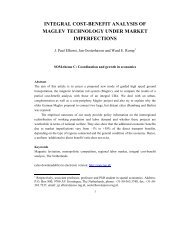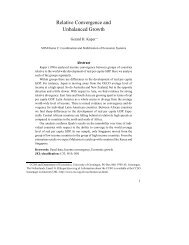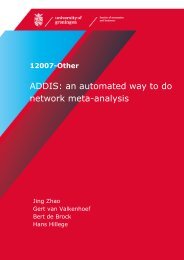Semiparametric Analysis to Estimate the Deal Effect Curve
Semiparametric Analysis to Estimate the Deal Effect Curve
Semiparametric Analysis to Estimate the Deal Effect Curve
Create successful ePaper yourself
Turn your PDF publications into a flip-book with our unique Google optimized e-Paper software.
Table 5.6: Dutch food data: description of deal effect curves a<br />
Shape Threshold Saturation<br />
level b level b<br />
own-item deal effect curves<br />
PD 3 → S 3 reverse S 5% 15%<br />
PD 4 → S 4 reverse S 10% 25%<br />
cross-item deal effect curves<br />
PD 3 → S 1 linear none none<br />
PD 3 → S 2 S 5% 10%<br />
PD 4 → S 3 concave 10% 30%<br />
PD 3 → S 4 S 5% 10%<br />
a only those with significant parametric deal effects<br />
b rounded <strong>to</strong> <strong>the</strong> nearest multiple of 5%<br />
price index. Analogous <strong>to</strong> <strong>the</strong> two-dimensional own-item and cross-item deal effect<br />
curves (Figures 5.1-5.6), we can construct a three-dimensional deal effect surface. To<br />
obtain a reliable surface we need observations with a price discount for two (or more)<br />
items simultaneously. Out of <strong>the</strong> 1456 tuna observations, 114 represent situations in<br />
which items 1 and 2 both have price discounts.<br />
We show two deal effect surfaces in Figure 5.7-5.8. In Figure 5.7 <strong>the</strong> vertical axis<br />
represents <strong>the</strong> predicted sales volume of item 1. The o<strong>the</strong>r two axes represent <strong>the</strong><br />
price indices of items 1 and item 2 respectively. The <strong>to</strong>p part of <strong>the</strong> three-dimensional<br />
surface (<strong>the</strong> curve A-B) is item 1’s own-item deal effect, also shown in Figure 5.1,<br />
when <strong>the</strong> o<strong>the</strong>r two items both have a price index of one. The figure shows that<br />
this curve tends <strong>to</strong> decrease in magnitude with a decrease in item 2’s price index.<br />
But, while <strong>the</strong>re is little evidence of saturation when item 2’s index equals one,<br />
saturation is very clear when item 2’s index is about 0.85 or less. Thus, <strong>the</strong> interaction<br />
effect is highly nonlinear which would be very difficult <strong>to</strong> model parametrically.<br />
Substantively, if item 1 is promoted with a deep discount (when its price index is<br />
≤ 0.75), item 2 can reduce item 1’s sales gain considerably if it also has a price index<br />
is ≤ 0.75.<br />
We show <strong>the</strong> interaction effect for <strong>the</strong> same price indices on item 2’s sales in Figure<br />
5.8. Here, <strong>the</strong> curve A-B represents item 2’s own-item deal effect, when items 1<br />
and 3 have a price index of one (see Figure 5.1). This curve also tends <strong>to</strong> decrease<br />
in magnitude when <strong>the</strong> price index of item 1 decreases, but <strong>the</strong> decrease is not as<br />
dramatic as it is in Figure 5.7. The own-item deal effect for item 2 appears <strong>to</strong> be less<br />
sensitive <strong>to</strong> item 1’s discounting than vice versa. Thus, <strong>the</strong> interaction effects appear<br />
<strong>to</strong> be asymmetric.<br />
24



